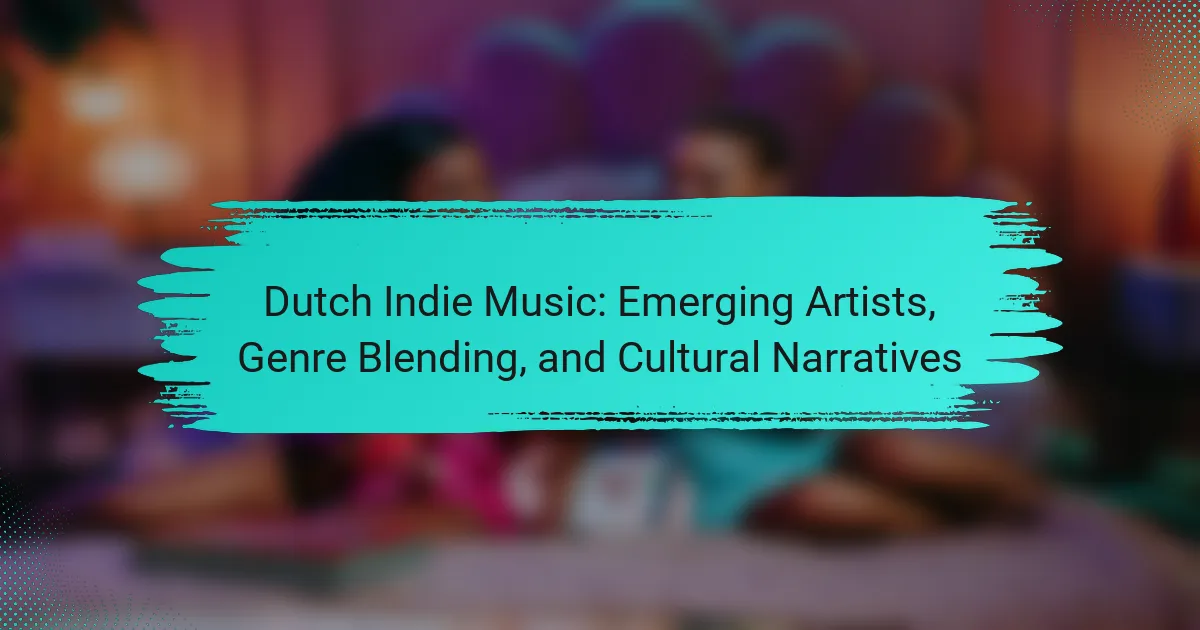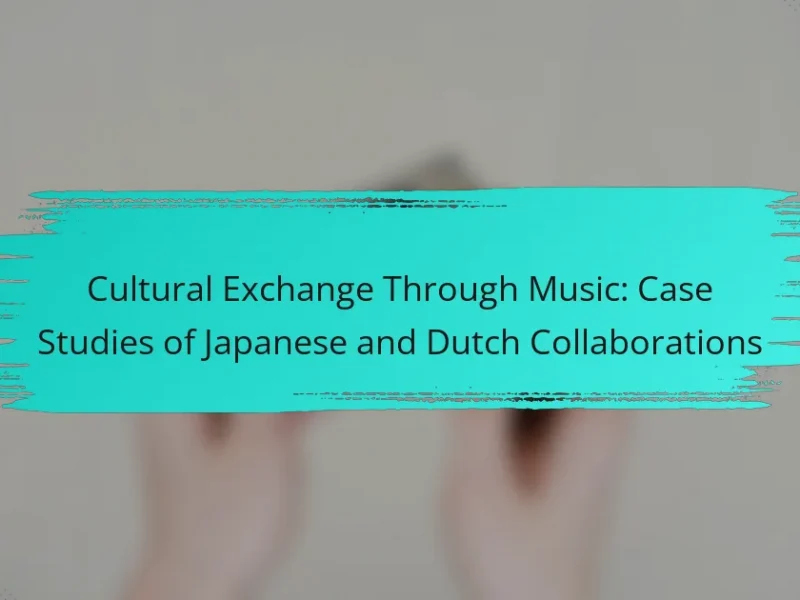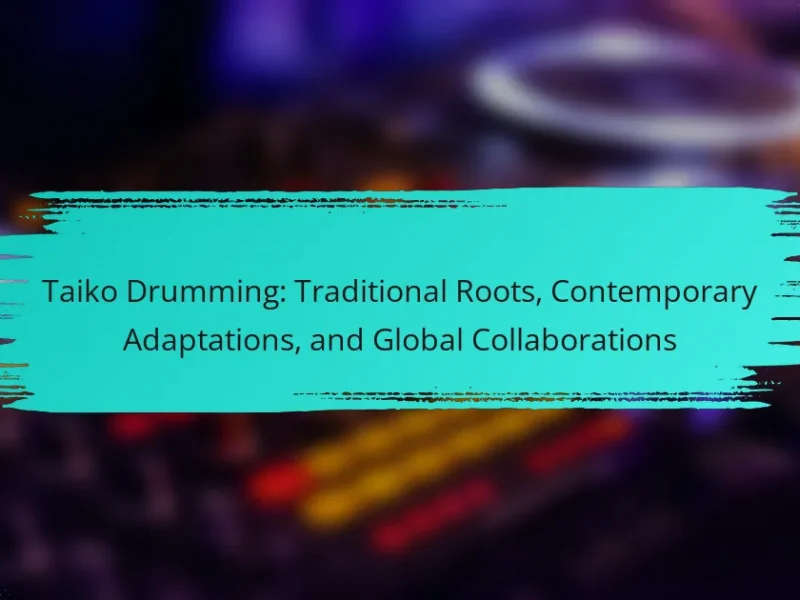Dutch indie music offers a vibrant landscape shaped by emerging artists who blend genres and tell cultural narratives. This article explores notable artists like Pip Blom and Aafke Romeijn, the role of music festivals in promoting visibility, and the impact of social media platforms such as Spotify and Instagram. Additionally, it examines the challenges these artists face in gaining recognition within a competitive industry.
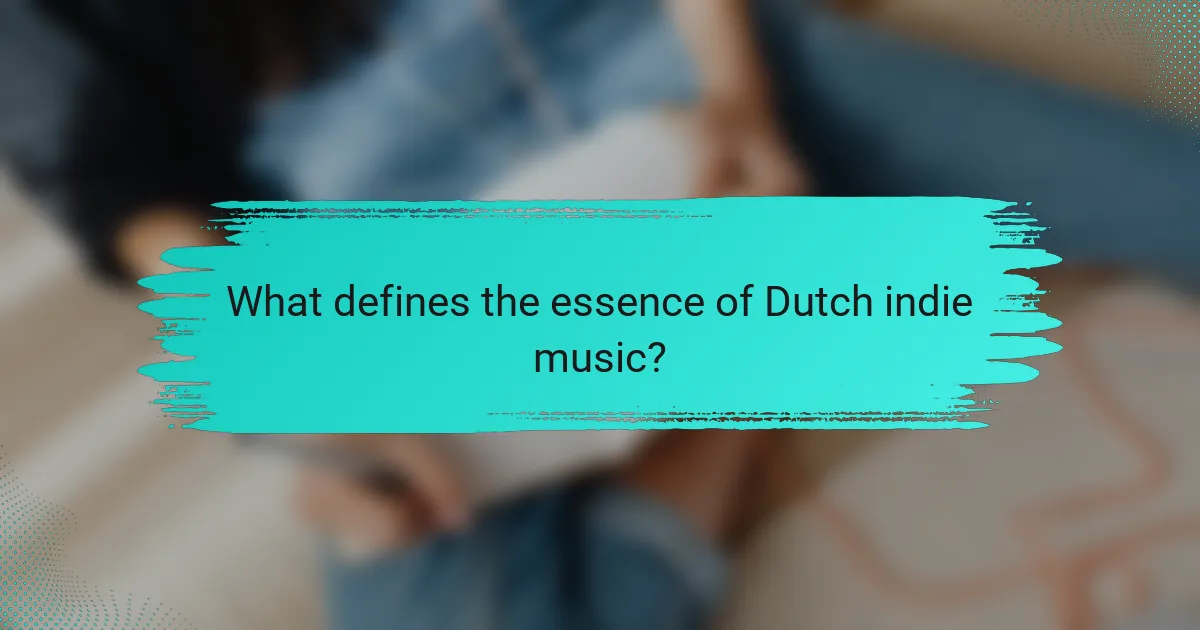
What defines the essence of Dutch indie music?
Dutch indie music is defined by its innovative sound, diverse influences, and storytelling. Emerging artists often blend genres like rock, pop, and electronic, creating a unique musical landscape. Cultural narratives in lyrics reflect contemporary Dutch society, addressing themes of identity and social issues. This genre thrives on collaboration, fostering a community that supports artistic exploration and experimentation.
How does genre blending shape the sound of emerging artists?
Genre blending significantly enhances the sound of emerging Dutch indie artists by fostering creativity and diversity. This approach allows artists to experiment with various musical styles, leading to unique soundscapes that reflect their cultural narratives. As a result, genre-blending artists often attract broader audiences and create innovative tracks that challenge conventional music boundaries. This trend is evident in the rising popularity of artists who combine elements from rock, electronic, and folk genres, showcasing their versatility and individuality. Such sonic experimentation is crucial for defining the contemporary Dutch indie music scene.
Which cultural narratives influence the themes in Dutch indie music?
Cultural narratives in Dutch indie music are shaped by themes of identity, social issues, and historical context. Artists often explore personal and collective experiences, reflecting the diverse cultural landscape of the Netherlands. For example, the influence of Dutch history, such as colonialism and immigration, is prevalent in lyrics and sound. Additionally, the blending of genres, like folk and electronic, allows for innovative storytelling that resonates with contemporary societal challenges. This genre’s unique attribute is its ability to merge traditional Dutch sounds with global influences, creating a rich tapestry of cultural expression.
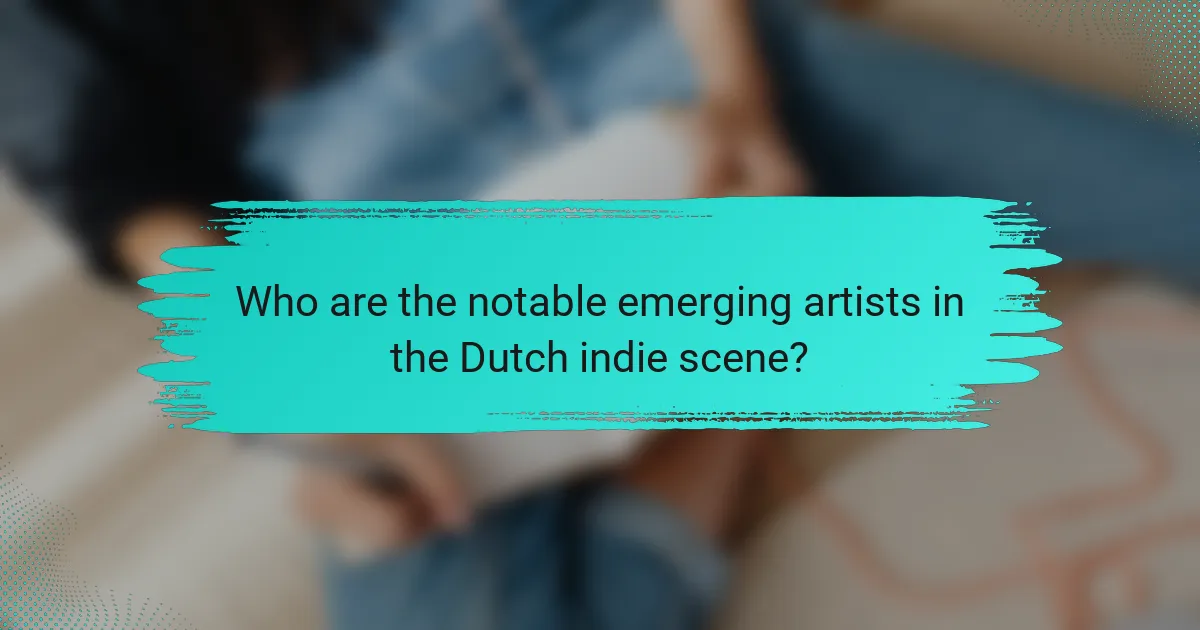
Who are the notable emerging artists in the Dutch indie scene?
Notable emerging artists in the Dutch indie scene include Pip Blom, who blends catchy melodies with introspective lyrics, and Aafke Romeijn, known for her poetic storytelling. Other artists like Froukje and Jett Rebel are gaining recognition for their unique sounds and cultural narratives. This diverse scene showcases a rich mix of genres and influences.
What unique sounds do artists like Pip Blom and Personal Trainer bring to the genre?
Pip Blom and Personal Trainer bring distinctive sounds to Dutch indie music through genre-blending and innovative styles. Pip Blom combines catchy melodies with a raw, energetic vibe, often reflecting personal experiences. Personal Trainer, on the other hand, infuses elements of post-punk and experimental sounds, creating a unique sonic landscape. Both artists contribute to a vibrant cultural narrative in the Dutch indie scene, showcasing diverse influences and fresh perspectives. Their music resonates with a younger audience, emphasizing authenticity and creativity.
How do collaborations among artists enhance the indie music landscape?
Collaborations among artists significantly enrich the indie music landscape by fostering creativity and innovation. These partnerships enable genre blending, allowing artists to experiment with diverse sounds and styles. For instance, Dutch indie musicians often collaborate across genres, creating unique cultural narratives that resonate with broader audiences. This synergy not only enhances individual artistry but also strengthens the community, promoting a vibrant and dynamic music scene. Such collaborations can lead to increased visibility and opportunities for emerging artists, ultimately shaping the future of indie music.
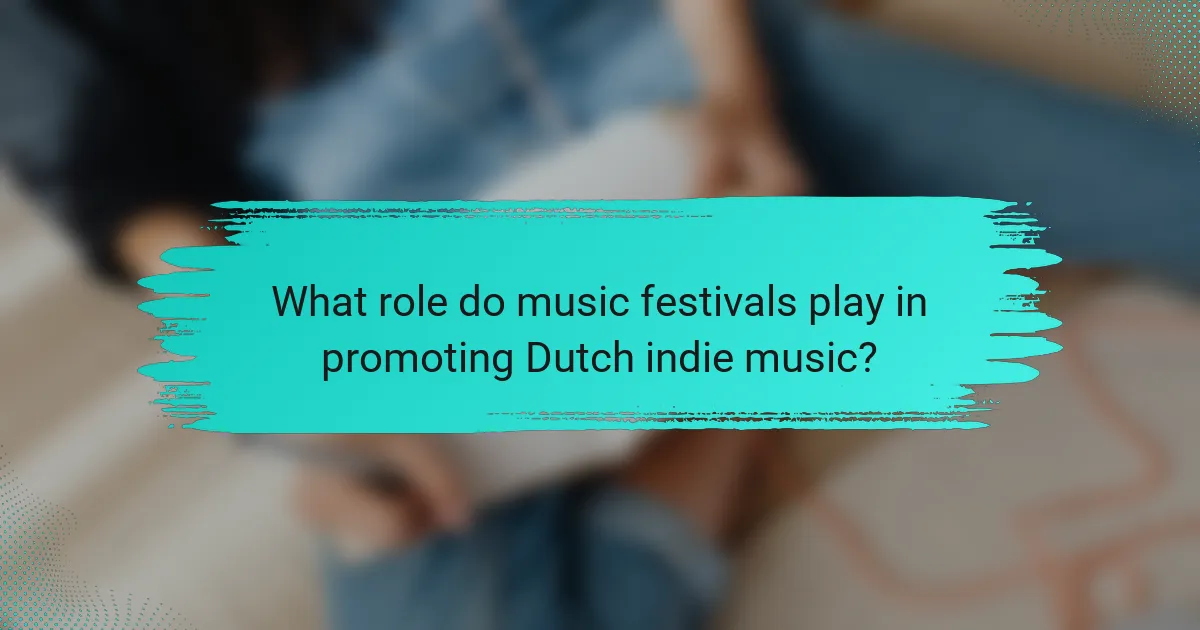
What role do music festivals play in promoting Dutch indie music?
Music festivals significantly promote Dutch indie music by providing platforms for emerging artists to showcase their work. These events foster genre blending, allowing diverse musical influences to merge and create unique sounds. Festivals also cultivate cultural narratives that resonate with local and international audiences, enhancing the visibility of Dutch indie music. As a result, they contribute to a vibrant music scene that supports artistic growth and community engagement.
Which festivals are essential for discovering new talent in 2025?
In 2025, essential festivals for discovering new talent in Dutch indie music include Eurosonic Noorderslag, Amsterdam Dance Event, and Le Guess Who?. These festivals showcase emerging artists blending genres and cultural narratives. Eurosonic features over 300 acts, highlighting diverse sounds. Amsterdam Dance Event focuses on electronic and indie fusion, attracting global attention. Le Guess Who? emphasizes cultural storytelling through music, offering unique experiences.
How do festival experiences contribute to the cultural narratives of Dutch indie music?
Festival experiences significantly enhance cultural narratives in Dutch indie music by fostering community engagement and showcasing diverse talents. These events provide a platform for emerging artists to blend genres, creating a rich tapestry of sounds that reflect contemporary societal themes. Festivals often highlight unique attributes of artists, such as their innovative styles and personal stories, which resonate with audiences. As a result, these experiences contribute to a collective identity within the Dutch indie music scene, reinforcing its cultural significance and evolution.
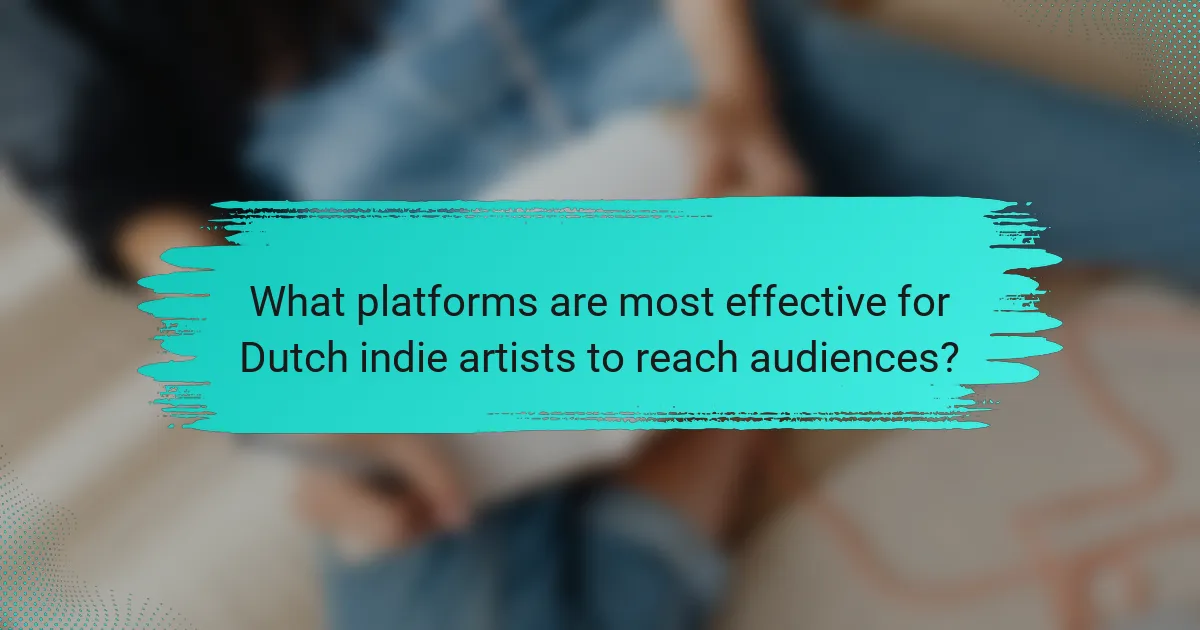
What platforms are most effective for Dutch indie artists to reach audiences?
Social media platforms like Instagram, Spotify, and YouTube are most effective for Dutch indie artists to reach audiences. These platforms facilitate direct engagement, showcase artistic content, and promote music.
Instagram allows visual storytelling, engaging fans through posts and stories. Spotify provides access to a vast audience with curated playlists, enhancing discoverability. YouTube serves as a platform for music videos and behind-the-scenes content, fostering a deeper connection with listeners.
Emerging artists benefit from these platforms’ unique attributes, such as algorithm-driven recommendations on Spotify and the viral potential of Instagram reels. These tools support genre blending and cultural narratives, essential in the Dutch indie music scene.
How does social media influence the visibility of emerging artists?
Social media significantly enhances the visibility of emerging artists by providing platforms for direct audience engagement. It allows artists to showcase their genre-blending music and cultural narratives, reaching wider audiences without traditional gatekeepers.
Platforms like Instagram and TikTok enable artists to share snippets of their work, gaining traction through viral trends. As a result, emerging Dutch indie musicians can build a loyal fan base and collaborate with other artists, fostering community and innovation.
Data shows that artists utilizing social media effectively can increase their follower count by over 40% within months. This growth translates into more opportunities for live performances and collaborations, further amplifying their reach.
Moreover, social media algorithms favor engaging content, allowing unique voices to rise above the noise. This democratization of visibility is crucial for emerging artists navigating the competitive landscape of the music industry.
Which streaming services are popular among Dutch indie music fans?
Dutch indie music fans prefer streaming services like Spotify, Apple Music, and Bandcamp. These platforms offer extensive catalogs of emerging artists and genre-blending tracks. Spotify leads with over 70 million songs, making it a favorite for discovering new Dutch indie sounds. Bandcamp is notable for its direct artist support, allowing fans to purchase music directly. Apple Music provides curated playlists that highlight local talent, enhancing cultural narratives within the genre.
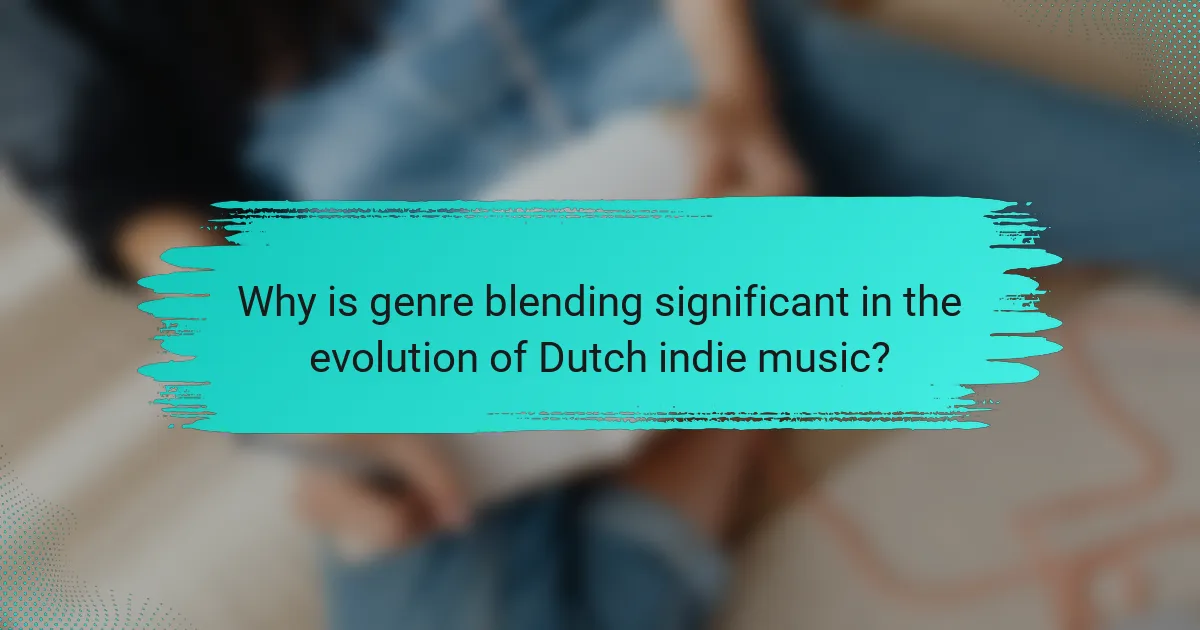
Why is genre blending significant in the evolution of Dutch indie music?
Genre blending is significant in the evolution of Dutch indie music as it fosters innovation and diversity. Emerging artists combine elements from various genres, creating unique sounds that reflect cultural narratives. This fusion enhances the music’s appeal, attracting a broader audience and encouraging collaboration. As a result, genre blending drives the growth of the indie scene, allowing artists to express their identities and experiences more authentically. The unique attribute of this movement lies in its ability to challenge traditional norms, paving the way for a dynamic musical landscape.
What are the most common genre fusions found in the current scene?
Dutch indie music showcases diverse genre fusions, often blending rock, electronic, and folk elements. Artists like Pip Blom and Snail Mail exemplify this trend, merging melodic hooks with experimental sounds. The cultural narratives within these fusions reflect contemporary themes, resonating with a broad audience. Unique attributes of this scene include the integration of local dialects and storytelling, enhancing authenticity.
How do artists navigate the challenges of genre classification?
Artists navigate genre classification challenges by embracing fluidity and blending styles. This approach allows them to reach diverse audiences and express their unique identities. Emerging Dutch indie musicians often incorporate elements from various genres, creating a rich tapestry of sound that defies traditional labels.
Cultural narratives play a crucial role in this process. Artists draw inspiration from their backgrounds and experiences, which inform their music and help them connect with listeners on a deeper level. Additionally, collaborations with artists from different genres further enhance this blending, resulting in innovative sounds that challenge conventional genre boundaries.
As a result, these artists not only redefine their musical identities but also contribute to the evolving landscape of Dutch indie music, making it more inclusive and dynamic.
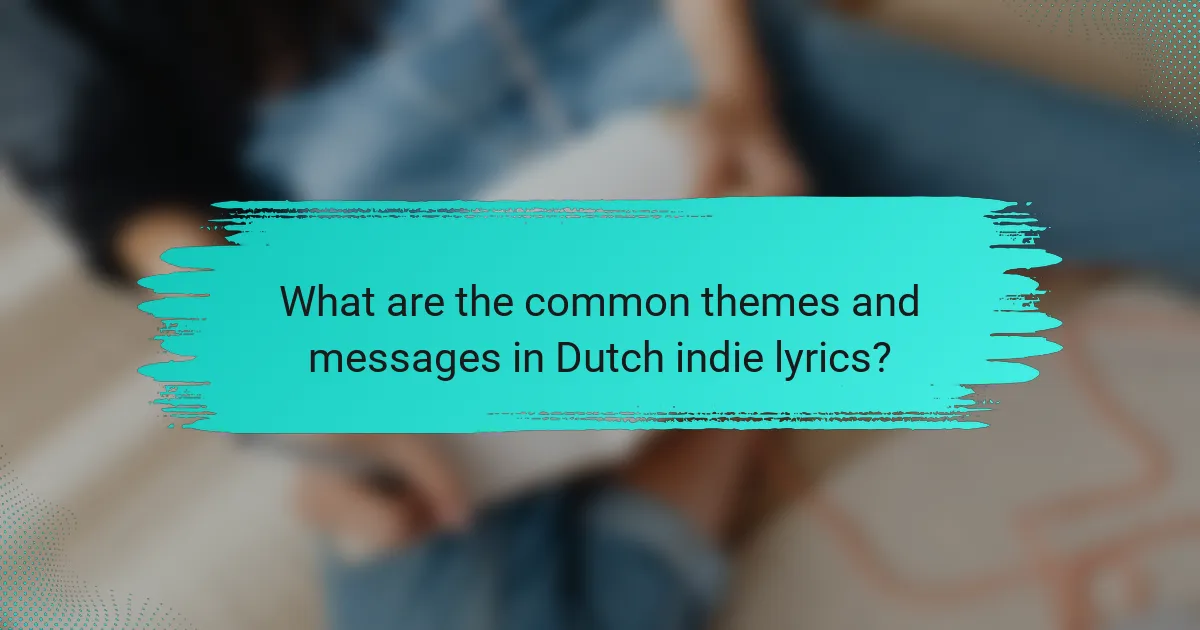
What are the common themes and messages in Dutch indie lyrics?
Dutch indie lyrics often explore themes of introspection, social commentary, and cultural identity. Emerging artists blend genres, infusing folk, electronic, and pop elements. Common messages reflect personal struggles, societal issues, and a quest for authenticity. These narratives resonate with listeners, highlighting the unique Dutch cultural landscape.
How do personal and societal issues shape lyrical content?
Personal and societal issues significantly influence lyrical content in Dutch indie music. Emerging artists often reflect cultural narratives, addressing themes like identity, social justice, and personal struggles. These elements resonate with audiences, fostering connections through shared experiences. Genre blending further enriches this dialogue, allowing artists to explore diverse perspectives and soundscapes. As a result, the music captures the complexities of contemporary life in the Netherlands, making it a vital part of the cultural landscape.
Which artists are known for their storytelling abilities in songwriting?
Artists known for their storytelling abilities in Dutch indie music include Aafke Romeijn, who explores personal narratives, and Jett Rebel, known for his vivid imagery. Other notable names are Pip Blom, who blends humor with introspection, and Eefje de Visser, whose lyrics reflect cultural themes. These artists effectively weave narratives into their songs, showcasing the depth of Dutch indie music.
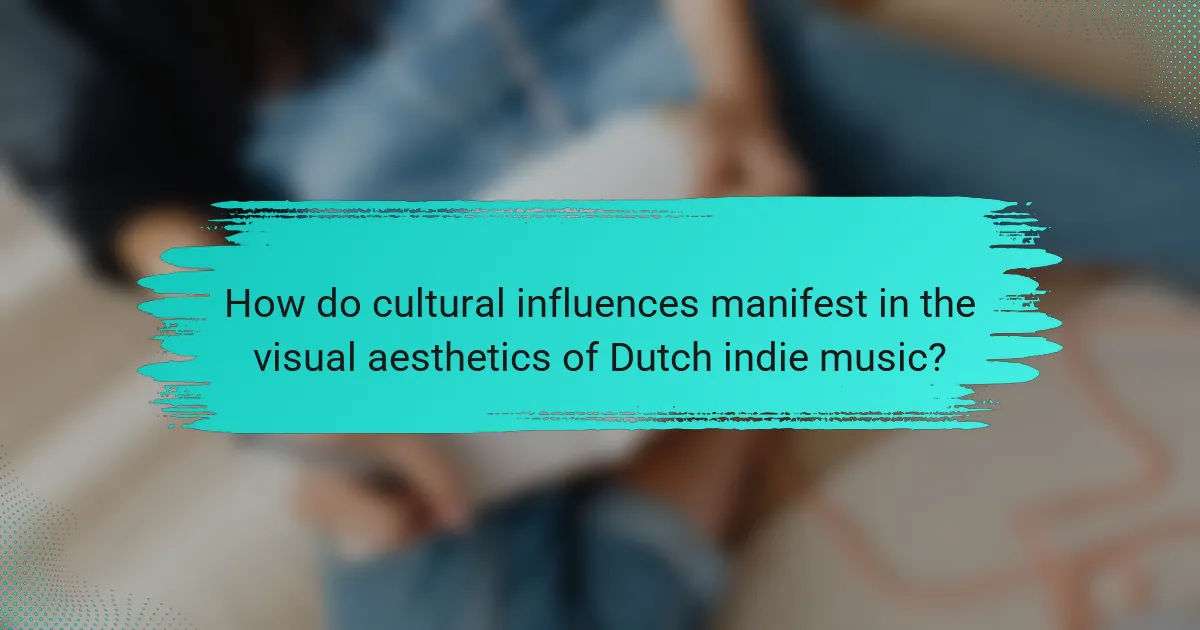
How do cultural influences manifest in the visual aesthetics of Dutch indie music?
Cultural influences manifest in the visual aesthetics of Dutch indie music through vibrant imagery, eclectic styles, and thematic narratives. Artists often blend traditional Dutch art with contemporary visuals, creating a unique cultural dialogue. This integration reflects the country’s rich artistic heritage, characterized by bold colors and innovative designs. Many emerging artists draw inspiration from Dutch painters, infusing their music videos and album art with references to iconic works. As a result, the visual representation becomes a powerful extension of the music, enhancing the storytelling aspect and appealing to both local and international audiences.
What role does artwork and branding play in an artist’s identity?
Artwork and branding significantly shape an artist’s identity by establishing a recognizable visual and thematic presence. In Dutch indie music, emerging artists often blend genres and cultural narratives, using artwork to reflect their unique stories and influences. This visual representation helps differentiate them in a competitive landscape. A strong brand identity can enhance audience connection, making their music more relatable and memorable. Unique artwork often embodies the artist’s personal journey, while effective branding can amplify their cultural narratives, fostering a deeper engagement with listeners.
How do music videos enhance the narrative experience of songs?
Music videos enhance the narrative experience of songs by visually interpreting themes and emotions. They provide a creative context that deepens listener engagement. For Dutch indie music, emerging artists often blend genres, adding layers to their storytelling. This fusion creates a unique narrative style that resonates culturally, enriching the overall experience. Visual elements in music videos help convey complex messages, making them memorable and impactful.
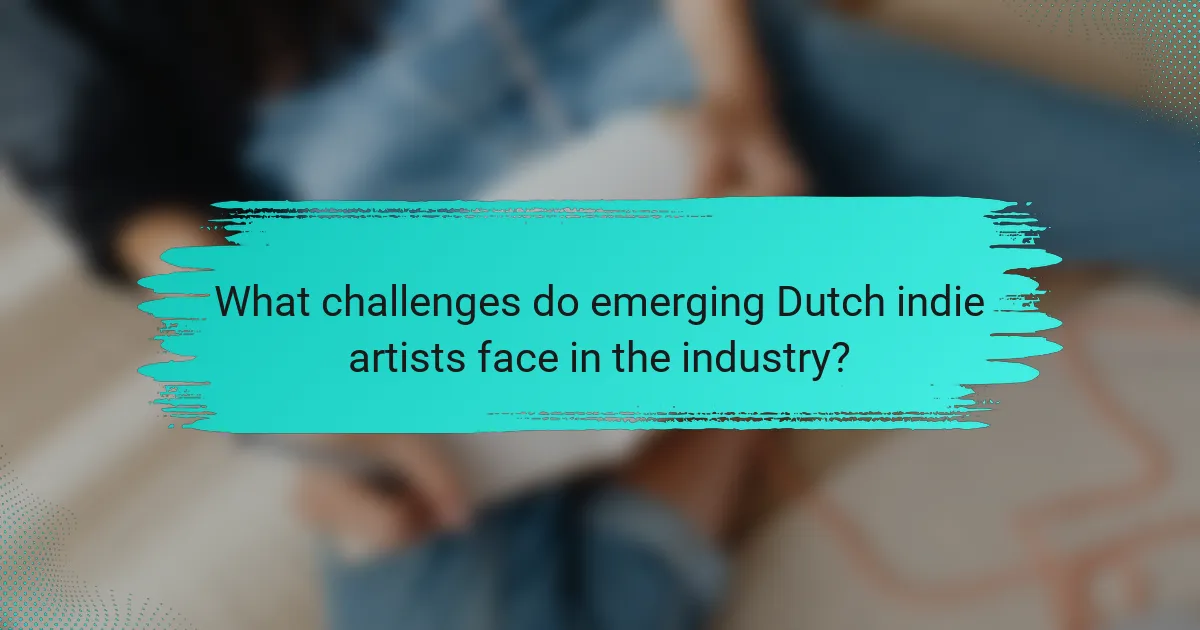
What challenges do emerging Dutch indie artists face in the industry?
Emerging Dutch indie artists face significant challenges in gaining visibility and funding. Limited access to mainstream media hinders their ability to reach wider audiences. Additionally, competition from established artists creates barriers to entry. Financial instability affects their capacity to produce quality music and promote effectively. Networking opportunities are often scarce, making collaborations difficult. Lastly, navigating the complex music industry landscape can be overwhelming for new artists.
How does funding and support differ for indie artists compared to mainstream acts?
Funding and support for indie artists typically comes from grassroots initiatives, while mainstream acts often rely on major label backing. Indie artists frequently seek crowdfunding, local grants, and community support, emphasizing personal connections. In contrast, mainstream acts benefit from substantial financial resources, marketing budgets, and industry connections. The disparity influences creative freedom; indie artists often experiment with genre blending, while mainstream acts may prioritize commercial viability.
What strategies can artists use to overcome common obstacles?
Artists can overcome common obstacles by embracing collaboration, leveraging digital platforms, and maintaining resilience. Collaboration fosters creativity and expands networks, allowing artists to share resources and ideas. Digital platforms offer exposure and engagement opportunities, helping artists connect with audiences and industry professionals. Resilience is crucial for navigating challenges, enabling artists to adapt and persist in their careers.
What are best practices for promoting new releases in the indie music scene?
To effectively promote new releases in the indie music scene, artists should utilize social media, engage with local communities, and collaborate with other musicians. Building a strong online presence is crucial for reaching wider audiences.
Social media platforms like Instagram and TikTok allow artists to share snippets of their music and connect with fans. Engaging with local music venues and participating in community events can enhance visibility. Collaborations with other indie artists can introduce new listeners and create unique sounds, reflecting the genre-blending nature of Dutch indie music.
Additionally, leveraging streaming platforms and music blogs can amplify reach. Submitting tracks to playlists and seeking reviews can generate buzz. Each of these strategies aligns with the cultural narratives that characterize the indie scene, emphasizing authenticity and creativity.
